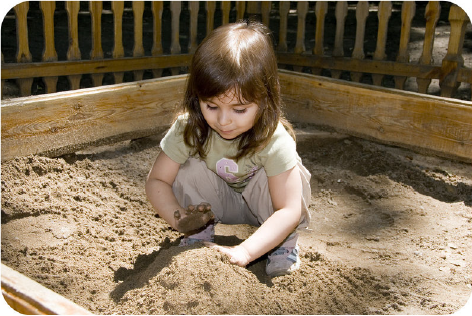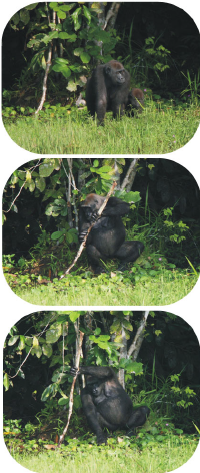Reading: Learned Behavior of Animals
Jessica Harwood
Douglas Wilkin, Ph.D.
http://www.ck12.org/saythanks
• Distinguish between learned behavior and innate behavior.
• Describe habituation.
• Explain observational learning
• Give examples of conditioning.
• Summarize learning by playing.
• Define insight learning.
Do you play a sport?
If you play a sport like soccer, then you realize it takes a lot of work. Remember how you didn’t know at all what you were doing when you first started? You had rules to figure out and skills to practice. Playing a sport is an example of a learned behavior.
Learned Behavior
Just about all human behaviors are learned. Learned behavior is behavior that occurs only after experience or practice. Learned behavior has an advantage over innate behavior: it is more flexible. Learned behavior can be changed if conditions change. For example, you probably know the route from your house to your school. Assume that you moved to a new house in a different place, so you had to take a different route to school. What if following the old route was an innate behavior? You would not be able to adapt. Fortunately, it is a learned behavior. You can learn the new route just as you learned the old one.
Although most animals can learn, animals with greater intelligence are better at learning and have more learned behaviors. Humans are the most intelligent animals. They depend on learned behaviors more than any other species. Other highly intelligent species include apes, our closest relatives in the animal kingdom. They include chimpanzees and gorillas. Both are also very good at learning behaviors.
You may have heard of a gorilla named Koko. The psychologist, Dr. Francine Patterson, raised Koko. Dr. Patterson wanted to find out if gorillas could learn human language. Starting when Koko was just one year old, Dr. Patterson taught her to use sign language. Koko learned to use and understand more than 1,000 signs. Koko showed how much gorillas can learn.
Think about some of the behaviors you have learned. They might include riding a bicycle, using a computer, and playing a musical instrument or sport. You probably did not learn all of these behaviors in the same way. Perhaps you learned some behaviors on your own, just by practicing. Other behaviors you may have learned from other people. Humans and other animals can learn behaviors in several different ways.
The following methods of learning will be explored below:
1. Habituation (forming a habit)
2. Observational learning
3. Conditioning
4. Play
5. Insight learning
Habituation
Habituation is learning to get used to something after being exposed to it for a while. Habituation usually involves getting used to something that is annoying or frightening, but not dangerous. Habituation is one of the simplest ways of learning. It occurs in just about every species of animal.
You have probably learned through habituation many times. For example, maybe you were reading a book when someone turned on a television in the same room. At first, the sound of the television may have been annoying. After a while, you may no longer have noticed it. If so, you had become habituated to the sound.
Another example of habituation is shown below ( Figure 1.1). Crows and most other birds are usually afraid of people. They avoid coming close to people, or they fly away when people come near them. The crows landing on this scarecrow have become used to a “human” in this place. They have learned that the scarecrow poses no danger. They are no longer afraid to come close. They have become habituated to the scarecrow.
Can you see why habituation is useful? It lets animals ignore things that will not harm them. Without habituation, animals might waste time and energy trying to escape from things that are not really dangerous.
Observational Learning
Observational learning is learning by watching and copying the behavior of someone else. Human children learn many behaviors this way. When you were a young child, you may have learned how to tie your shoes by watching your dad tie his shoes. More recently, you may have learned how to dance by watching a pop star dancing on TV. Most likely, you have learned how to do math problems by watching your teachers do problems on the board at school. Can you think of other behaviors you have learned by watching and copying other people?
Other animals also learn through observational learning. For example, young wolves learn to be better hunters by watching and copying the skills of older wolves in their pack. Another example of observational learning is how some monkeys have learned to wash their food. They learned by watching and copying the behavior of other
monkeys.

FIGURE 1.1
This scarecrow is no longer scary to this crow. The crow has become used to its being in this spot and learned that it is not dangerous. This is an example of habituation.
Conditioning
Conditioning is a way of learning that involves a reward or punishment. Did you ever train a dog to fetch a ball or stick by rewarding it with treats? If you did, you were using conditioning. Another example of conditioning is shown in the video below; the rats have been taught to “play basketball” by being rewarded with food pellets. What do you think would happen if the rats were no longer rewarded for this behavior?
Conditioning also occurs in wild animals. For example, bees learn to find nectar in certain types of flowers because they have found nectar in those flowers before.
Humans learn behaviors through conditioning, as well. A young child might learn to put away his toys by being rewarded with a bedtime story. An older child might learn to study for tests in school by being rewarded with better grades. Can you think of behaviors you have learned by being rewarded for them?
Conditioning does not always involve a reward. It can involve a punishment, instead. A toddler might be punished with a time-out each time he grabs a toy from his baby brother. After several time-outs, he may learn to stop taking his brother’s toys.
A dog might be scolded each time she jumps up on the sofa. After repeated scolding, she may learn to stay off the sofa. A bird might become ill after eating a poisonous insect. The bird may learn from this “punishment” to avoid eating the same kind of insect in the future.
Learning by Playing
Most young mammals, including humans, like to play. Play is one ways they learn the skills that they will need as adults. Think about how kittens play. They pounce on toys and chase each other. This helps them learn how to be better predators when they are older. Big cats also play. The lion cubs pictured below are playing and practicing their hunting skills at the same time ( Figure 1.2). The dogs are playing tug-of-war with a toy ( Figure 1.2). What do you think they are learning by playing together this way?
Other young animals play in different ways. For example, young deer play by running and kicking up their hooves. This helps them learn how to escape from predators.

FIGURE 1.2
Left: These two lion cubs are playing. They are not only having fun, but they are also learning how to be better hunters. Right: These dogs are really playing. This play fighting can help them learn how to be better predators.
Human children learn by playing as well. For example, playing games and sports can help them learn to follow rules and work with others. The toddlers pictured below are playing in the sand ( Figure 1.3). They are learning about the world through play. What do you think they might be learning?

FIGURE 1.3
Playing in a sandbox is fun for young children. It can also help them learn about the world.
Insight Learning
Insight learning is learning from past experiences and reasoning. It usually involves coming up with new ways to solve problems. Insight learning generally happens quickly. An animal has a sudden flash of insight. Insight learning requires relatively great intelligence. Human beings use insight learning more than any other species. They have used their intelligence to solve problems ranging from inventing the wheel to flying rockets into space.
Think about problems you have solved. Maybe you figured out how to solve a new type of math problem or how to get to the next level of a video game. If you relied on your past experiences and reasoning to do it, then you were using insight learning.
One type of insight learning is making tools to solve problems. Scientists used to think that humans were the only animals intelligent enough to make tools. In fact, tool-making was believed to set humans apart from all other animals.
In 1960, primate expert Jane Goodall discovered that chimpanzees also make tools. She saw a chimpanzee strip leaves from a twig. Then he poked the twig into a hole in a termite mound. After termites climbed onto the twig, he pulled the twig out of the hole and ate the insects clinging to it. The chimpanzee had made a tool to “fish” for termites. He had used insight to solve a problem. Since then, chimpanzees have been seen making several different types of tools. For example, they sharpen sticks and use them as spears for hunting. They use stones as hammers to crack open nuts.
Scientists have also observed other species of animals making tools to solve problems. A crow was seen bending a piece of wire into a hook. Then the crow used the hook to pull food out of a tube.
An example of a gorilla using a walking stick is shown below ( Figure 1.4). Behaviors such as these show that other species of animals can use their experience and reasoning to solve problems. They can learn through insight.

FIGURE 1.4
This gorilla is using a branch as a tool. She is leaning on it to keep her balance while she reaches down into swampy water to catch a fish.
Summary
• Learned behavior is behavior that occurs only after experience or practice.
• Methods of learning include habituation, observational learning, conditioning, play, and insight learning.
Review
1. What is observational learning? Give an example.
2. What is conditioning?
3. Why are some crows not afraid of scarecrows?
4. Describe insight learning. Give an example.
